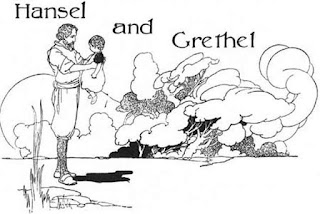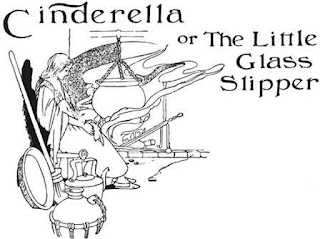Hansel and Gretel
Hansel and Gretel, illustrated by Charles Robinson
(A classic fairy tale with a bit of twist)
This story was published in The Big Book of Fairy Tales, edited by Walter Jerrold.
The publisher was Blackie & Son in 1911.
Hansel and Gretel live with their father and stepmother. Father is a poor woodcutter. They are all hungry. Stepmother gets the idea to take the kids into the woods and leave them there so there would be two hungry mouths at the house. Father doesn't like the idea but she persists.
Hansel tells this to his sister. He has a plan. He sneaks out of the house and fills his pockets with white pebbles so he can drop them on their way to the forest, and the kids can later find their way home.
The plan works. Hansel and Gretel are left in the woods but return home following the trace of the pebbles.
Unfortunately, their stepmother insists on taking them to the forest again. This time, the door is locked, so Hansel can't take the pebbles. He tries to mark the way with bread crumbs but the birds eat them.
Children are lost in the dark forest.
They wander around, hungry and scared, until they find a house.
It's a very special house made of gingerbread and covered by cake. Hansel and Gretel can finally eat as much as they want.
When the owner of the house opens the door, they don't suspect anything bad. They don't know that a nice lady who invites them in is a cannibalistic witch who has this house to lure children into her home. And into her oven!
Hansel and Gretel become her prisoners.
Hansel is locked in a cage and Gretel must serve the witch. The witch wants to put some weight on the kids before making a roast. This gives some time to Hansel and Gretel before they face their cruel destiny.
But the witch is impatient.
In the meantime, their father misses the kids. His wife dies and he decides to look for children.
A friend goes with him.
They are searching for a long time and spot a doe.
The doe acts strangely. It looks like it wants them to follow it. So they follow the doe.
The doe leads the men to the witch's house. They kill the witch and save the children. The house is full of precious things, so everybody becomes rich and there will be no hunger.
The fairy tale about kids left in the woods by their parents is too horrifying for many. Numerous authors, translators, and editors tried to soften it and make it more suitable for children so they wouldn't suffer from nightmares and other traumas.
One such attempt is a Gingerbread House where children are simply lost in the woods.
You can find this fairy tale here.
The plot is almost the same but the family is not poor and all responsibility falls on the children. An elegant way to make parents better in the eyes of their audience, right?
Another attempt to make Hansel and Gretel more suitable for tender children's souls is Engelbert Humperdinck's opera with Adelheid Wette's libretto. In this version, Hansel and Gretel are lost, too. When they come to the witch's house, there are already many kids captured by the witch's spells and Hansel is her next victim. But Gretel manages to trick her and push her into the oven. When the witch dies all the children are free. See for yourself.
Both mentioned examples avoid addressing one of the primal fears of every child - to be abandoned by parents. In both cases, the kids are lost, and being lost is also one of the primal fears.
But it's not the same.
If you are lost, it's very likely your responsibility. If you are abandoned by your parents you are betrayed by the most important people in the world. How can you trust somebody again? Those situations are completely different. You can control one but not the other.
So these attempts don't offer to a listener nearly as much as the much darker Hansel and Gretel with dynamic distributions of powers among all five characters.
To check the real deal with a bit of symbolism explained, just go to https://owlcation.com/humanities/hansel_and_gretel. You won't regret it.














Komentarji
Objavite komentar